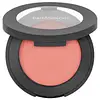What's inside
What's inside
 Key Ingredients
Key Ingredients

 Benefits
Benefits

 Concerns
Concerns

 Ingredients Side-by-side
Ingredients Side-by-side

Dimethicone
EmollientSilica
AbrasiveEthylhexyl Isononanoate
EmollientDiisostearyl Malate
EmollientBoron Nitride
AbsorbentTrimethylsiloxysilicate
EmollientDimethicone Crosspolymer
Emulsion StabilisingLycopodium Clavatum Extract
Skin ConditioningImperata Cylindrica Root Extract
Skin ConditioningEthylhexylglycerin
Skin ConditioningBHT
AntioxidantNylon-12
Sodium Hyaluronate
HumectantGlycerin
HumectantMethicone
EmollientCalcium Aluminum Borosilicate
Tin Oxide
AbrasiveCalcium Sodium Borosilicate
Synthetic Fluorphlogopite
Phenoxyethanol
PreservativeIron Oxides
CI 77742
Cosmetic ColorantMica
Cosmetic ColorantCI 15850
Cosmetic ColorantCI 77891
Cosmetic ColorantDimethicone, Silica, Ethylhexyl Isononanoate, Diisostearyl Malate, Boron Nitride, Trimethylsiloxysilicate, Dimethicone Crosspolymer, Lycopodium Clavatum Extract, Imperata Cylindrica Root Extract, Ethylhexylglycerin, BHT, Nylon-12, Sodium Hyaluronate, Glycerin, Methicone, Calcium Aluminum Borosilicate, Tin Oxide, Calcium Sodium Borosilicate, Synthetic Fluorphlogopite, Phenoxyethanol, Iron Oxides, CI 77742, Mica, CI 15850, CI 77891
Mica
Cosmetic ColorantSilica
AbrasiveIsononyl Isononanoate
EmollientTalc
AbrasiveNylon-12
Aluminum Starch Octenylsuccinate
AbsorbentDiisostearyl Malate
EmollientIsododecane
EmollientBoron Nitride
AbsorbentC20-24 Alkyl Dimethicone
Skin ConditioningPolybutene
Magnesium Myristate
Bis(Glycidoxyphenyl)Propane/Bisaminomethylnorbornane Copolymer
Aluminum Hydroxide
EmollientPhenoxyethanol
PreservativeEthylhexylglycerin
Skin ConditioningCI 77891
Cosmetic ColorantCI 15850
Cosmetic ColorantCI 45410
Cosmetic ColorantCI 45380
Cosmetic ColorantCI 16035
Cosmetic ColorantMica, Silica, Isononyl Isononanoate, Talc, Nylon-12, Aluminum Starch Octenylsuccinate, Diisostearyl Malate, Isododecane, Boron Nitride, C20-24 Alkyl Dimethicone, Polybutene, Magnesium Myristate, Bis(Glycidoxyphenyl)Propane/Bisaminomethylnorbornane Copolymer, Aluminum Hydroxide, Phenoxyethanol, Ethylhexylglycerin, CI 77891, CI 15850, CI 45410, CI 45380, CI 16035
Ingredients Explained
These ingredients are found in both products.
Ingredients higher up in an ingredient list are typically present in a larger amount.
Boron Nitride is compound consisting of boron and nitrogen. It is used to absorb oil and modify adherence/ slip in products.
This means it is often used in makeup products to help them last longer.
Ci 15850 is the pigment color red. It is an azo dye and created synthetically.
Azo dyes need to be thoroughly purified before use. This allows them to be more stable and longer-lasting.
This ingredient is common in foundations, lipsticks, and blushes. This color is described as brown/orangey red.
It has many secondary names such as Red 6 and Red 7. According to a manufacturer, Red 6 usually contains aluminum.
Learn more about CI 15850Ci 77891 is a white pigment from Titanium dioxide. It is naturally found in minerals such as rutile and ilmenite.
It's main function is to add a white color to cosmetics. It can also be mixed with other colors to create different shades.
Ci 77891 is commonly found in sunscreens due to its ability to block UV rays.
Learn more about CI 77891Diisostearyl Malate is an emollient and most often used in lip products. It comes from isostearyl alcohol, a fatty acid, and malic acid, an AHA.
As an emollient, Diisostearyl Malate helps create a thin film on your skin to trap moisture in. This helps keep your skin soft and smooth.
Ethylhexylglycerin (we can't pronounce this either) is commonly used as a preservative and skin softener. It is derived from glyceryl.
You might see Ethylhexylglycerin often paired with other preservatives such as phenoxyethanol. Ethylhexylglycerin has been found to increase the effectiveness of these other preservatives.
Mica is a naturally occurring mineral used to add shimmer and color in cosmetics. It can also help improve the texture of a product or give it an opaque, white/silver color.
Serecite is the name for very fine but ragged grains of mica.
This ingredient is often coated with metal oxides like titanium dioxide. Trace amounts of heavy metals may be found in mica, but these metals are not harmful in our personal products.
Mica has been used since prehistoric times throughout the world. Ancient Egyptian, Indian, Greek, Roman, Aztec, and Chinese civilizations have used mica.
Learn more about MicaNylon-12 is a polymer. It is derived from 12-aminododecanoic acid, an omega-amino fatty acid
According to a manufacturer, it is a talc substitute. Like talc, nylon-12 gives products a satin feel. The manufacturer also claims this ingredients does not block pores and has moderate oil absorption.
This ingredient may not be reef-safe.
Learn more about Nylon-12Phenoxyethanol is a preservative that has germicide, antimicrobial, and aromatic properties. Studies show that phenoxyethanol can prevent microbial growth. By itself, it has a scent that is similar to that of a rose.
It's often used in formulations along with Caprylyl Glycol to preserve the shelf life of products.
Silica, also known as silicon dioxide, is a naturally occurring mineral. It is used as a fine, spherical, and porous powder in cosmetics.
Though it has exfoliant properties, the function of silica varies depending on the product.
The unique structure of silica enhances the spreadability and adds smoothness, making it a great texture enhancer.
It is also used as an active carrier, emulsifier, and mattifier due to its ability to absorb excess oil.
In some products, tiny microneedles called spicules are made from silica or hydrolyzed sponge. When you rub them in, they lightly polish away dead skin layers and enhance the penetration of active ingredients.
Learn more about Silica